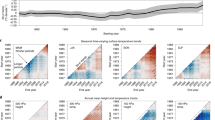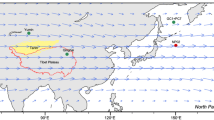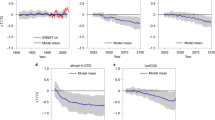Abstract
The Pacific trade winds, coupled with the zonal sea surface temperature gradient in the equatorial Pacific Ocean, control regional sea levels1, and therefore their trend is a great concern in the Pacific Rim. Over the past two decades, easterly winds have been accelerated in association with eastern tropical Pacific cooling2. They may represent natural interdecadal variability in the Pacific3 and possibly explain the recent global warming hiatus4,5,6,7. However, the intensification of the winds has been the strongest ever observed in the past century2,5,8, the reason for which is still unclear. Here we show, using multiple climate simulations for 1921–2014 by a global climate model, that approximately one-third of the trade-wind intensification for 1991–2010 can be attributed to changes in sulfate aerosols. The multidecadal sea surface temperature anomaly induced mostly by volcanic aerosols dominates in the western North Pacific, and its sign changed rapidly from negative to positive in the 1990s, coherently with Atlantic multidecadal variability9,10,11. The western North Pacific warming resulted in intensification of trade winds to the west of the dateline. These trends have not contributed much to the global warming hiatus, but have greatly impacted rainfall over the western Pacific islands.
This is a preview of subscription content, access via your institution
Access options
Subscribe to this journal
Receive 12 print issues and online access
$209.00 per year
only $17.42 per issue
Buy this article
- Purchase on Springer Link
- Instant access to full article PDF
Prices may be subject to local taxes which are calculated during checkout




Similar content being viewed by others
References
Merrifield, M. A. A shift in western tropical Pacific sea level trends during the 1990s. J. Clim. 24, 4126–4138 (2011).
L’Heureux, M. L., Lee, S. & Lyon, B. Recent multidecadal strengthening of the Walker circulation across the tropical Pacific. Nature Clim. Change 3, 571–576 (2013).
Meehl, G. A., Hu, A., Arblaster, J. M., Fasullo, J. Y. & Trenberth, K. E. Externally forced and internally generated decadal climate variability associated with the Interdecadal Pacific Oscillation. J. Clim. 26, 7298–7310 (2013).
Kosaka, Y. & Xie, S.-P. Recent global-warming hiatus tied to equatorial Pacific surface cooling. Nature 501, 403–407 (2013).
England, M. H. et al. Recent intensification of wind-driven circulation in the Pacific and the ongoing warming hiatus. Nature Clim. Change 4, 222–227 (2014).
Watanabe, M. et al. Contribution of natural decadal variability to global warming acceleration and hiatus. Nature Clim. Change 4, 893–897 (2014).
Dai, A., Fyfe, J. C., Xie, S.-P. & Dai, X. Decadal modulation of global surface temperature by internal climate variability. Nature Clim. Change 5, 555–560 (2015).
de Boisséson, E., Balmaseda, M. A., Abdalla, S., Källén, E. & Janssen, P. A. E. M. How robust is the recent strengthening of the tropical Pacific trade winds? Geophys. Res. Lett. 41, 4398–4405 (2014).
McGregor, S. et al. Recent Walker circulation strengthening and Pacific cooling amplified by Atlantic warming. Nature Clim. Change 4, 888–892 (2014).
Chikamoto, Y. et al. Skillful multi-year predictions of tropical trans-basin climate variability. Nature Commun. 6, 6869 (2015).
Li, X., Xie, S.-P., Gille, S. T. & Yoo, C. Atlantic-induced pan-tropical climate change over the past three decades. Nature Clim. Change 6, 275–279 (2015).
Watanabe, M. et al. Strengthening of ocean heat uptake efficiency associated with the recent climate hiatus. Geophys. Res. Lett. 40, 3175–3179 (2013).
Drijfhout, S. S. et al. Surface warming hiatus caused by increased heat uptake across multiple ocean basins. Geophys. Res. Lett. 41, 7868–7874 (2014).
Power, S., Casey, T., Folland, C., Colman, A. & Mehta, V. Interdecadal modulation of the impact of ENSO on Australia. Clim. Dynam. 15, 319–324 (1999).
Vecchi, G. A. et al. Weakening of tropical Pacific atmospheric circulation due to anthropogenic forcing. Nature 441, 73–76 (2006).
Held, I. M. & Soden, B. J. Robust responses of the hydrological cycle to global warming. J. Clim. 19, 5686–5699 (2006).
Boer, G. J. Decadal potential predictability of twenty-first century climate. Clim. Dynam. 36, 1119–1133 (2011).
Funk, C. C. & Hoell, A. The leading mode of observed CMIP5 ENSO-residual sea surface temperatures and associated changes in Indo-Pacific climate. J. Clim. 28, 4309–4329 (2015).
Booth, B. B. B., Dunstone, N. J., Halloran, P. R., Andrews, T. & Bellouin, N. Aerosols implicated as a prime driver of twentieth-century North Atlantic climate variability. Nature 484, 228–232 (2012).
Dunstone, N. J., Smith, D. M., Booth, B. B. B., Hermanson, L. & Eade, R. Anthropogenic aerosol forcing of Atlantic tropical storms. Nature Geosci. 6, 534–539 (2013).
Boo, K.-O. et al. Influence of aerosols in multidecadal SST variability simulations over the North Pacific. J. Geophys. Res. 120, 517–531 (2015).
Bollasina, M. A., Ming, Y. & Ramaswamy, V. Anthropogenic aerosols and the weakening of the South Asian summer monsoon. Science 334, 502–505 (2011).
Lohmann, U. & Feichter, J. Global indirect aerosol effects: a review. Atmos. Chem. Phys. 5, 715–737 (2005).
Zhang, R. et al. Have aerosols caused the observed Atlantic multidecadal variability? J. Atmos. Sci. 70, 1135–1144 (2013).
Santer, B. D. et al. Volcanic contribution to decadal changes in tropospheric temperature. Nature Geosci. 7, 185–189 (2014).
Maher, N., McGregor, S., England, M. H. & Gupta, A. S. Effects of volcanism on tropical variability. Geophys. Res. Lett. 42, 6024–6033 (2015).
Xie, S.-P., Lu, B. & Xiang, B. Similar spatial patterns of climate responses to aerosol and greenhouse gas changes. Nature Geosci. 6, 828–832 (2013).
Merrifield, M. A. & Maltrud, M. E. Regional sea level trends due to a Pacific trade wind intensification. Geophys. Res. Lett. 38, L21605 (2011).
Han, W. et al. Intensification of decadal and multi-decadal sea level variability in the western tropical Pacific during recent decades. Clim. Dynam. 43, 1357–1379 (2014).
Luo, J. J., Sasaki, W. & Masumoto, Y. Indian Ocean warming modulates Pacific climate change. Proc. Natl Acad. Sci. USA 109, 18701–18706 (2012).
Ishii, M. & Kimoto, M. Reevaluation of historical ocean heat content variations with time-varying XBT and MBT depth bias corrections. J. Oceanogr. 65, 287–299 (2009).
Compo, G. P. et al. The Twentieth Century Reanalysis project. Q. J. R. Meteorol. Soc. 137, 1–28 (2011).
Kobayashi, S. et al. The JRA-55 reanalysis: general specifications and basic characteristics. J. Meteorol. Soc. Japan 93, 5–48 (2015).
Adler, R. F. et al. The version 2 global precipitation climatology project (GPCP) monthly precipitation analysis (1979–Present). J. Hydrometeorol. 4, 1147–1167 (2003).
Takemura, T. et al. A simulation of the global distribution and radiative forcing of soil dust aerosols at the Last Glacial Maximum. Atmos. Chem. Phys. 9, 3061–3073 (2009).
Taylor, K. E., Stouffer, R. J. & Meehl, G. A. An overview of CMIP5 and the experiment design. Bull. Am. Meteorol. Soc. 93, 485–498 (2011).
Santer, B. D. et al. Statistical significance of trends and trend differences in layer-average atmospheric temperature time series. J. Geophys. Res. 105, 7337–7356 (2000).
Mahajan, S., Zhang, R. & Delworth, T. Impact of the Atlantic Meridional Overturning Circulation (AMOC) on Arctic surface air temperature and sea ice variability. J. Clim. 24, 6573–6581 (2011).
Cherian, R., Quaas, J., Salzmann, M. & Wild, M. Pollution trends over Europe constrain global aerosol forcing as simulated by climate models. Geophys. Res. Lett. 41, 2176–2181 (2014).
Morice, C. P., Kennedy, J. J., Rayner, N. A. & Jones, P. D. Quantifying uncertainties in global and regional temperature change using an ensemble of observational estimates: the HadCRUT4 dataset. J. Geophys. Res. 117, D08101 (2012).
Kucharski, F. I. S., Kang, R. F. & Laura, F. Tropical Pacific response to 20th century Atlantic warming. Geophys. Res. Lett. 38, L03702 (2011).
Wilcox, L. J., Highwood, E. J. & Dunstone, N. J. The influence of anthropogenic aerosol on multi-decadal variations of historical global climate. Environ. Res. Lett. 8, 024033 (2013).
Allen, R. J. A 21st century northward tropical precipitation shift caused by future anthropogenic aerosol reductions. J. Geophys. Res. 120, 9087–9102 (2015).
Rotstayn, L. D., Collier, M. A., Shindell, D. T. & Boucher, O. Why does aerosol forcing control historical global-mean surface temperature change in CMIP5 models? J. Clim. 28, 6608–6625 (2015).
Acknowledgements
We acknowledge the modelling groups, the Program For Climate Model Diagnosis and Intercomparison (PCMDI) and the Working Group on Coupled Modelling (WGCM) of the World Climate Research Programme (WCRP) for their efforts in making the CMIP5 multi-model data set available. We thank T. Tanaka for running MIROC5.2. This work was supported by Grant-in-Aid 24241009 and the Program for Risk Information on Climate Change (SOUSEI program) from the Ministry of Education, Culture, Sports, Science and Technology (MEXT), Japan.
Author information
Authors and Affiliations
Contributions
M.W. designed the study, conducted the numerical experiments, and wrote the paper. C.T. performed the analysis, prepared the figures, and helped write the manuscript.
Corresponding author
Ethics declarations
Competing interests
The authors declare no competing financial interests.
Supplementary information
Supplementary Information
Supplementary Information (PDF 2841 kb)
Rights and permissions
About this article
Cite this article
Takahashi, C., Watanabe, M. Pacific trade winds accelerated by aerosol forcing over the past two decades. Nature Clim Change 6, 768–772 (2016). https://doi.org/10.1038/nclimate2996
Received:
Accepted:
Published:
Issue Date:
DOI: https://doi.org/10.1038/nclimate2996
This article is cited by
-
Satellite-observed strong subtropical ocean warming as an early signature of global warming
Communications Earth & Environment (2023)
-
Forced changes in the Pacific Walker circulation over the past millennium
Nature (2023)
-
Reassessing the relative role of anthropogenic aerosols and natural decadal variability in driving the mid-twentieth century global “cooling”: a focus on the latitudinal gradient of tropospheric temperature
Climate Dynamics (2022)
-
A very likely weakening of Pacific Walker Circulation in constrained near-future projections
Nature Communications (2021)
-
New insights into future tropical climate change
Nature Climate Change (2021)



